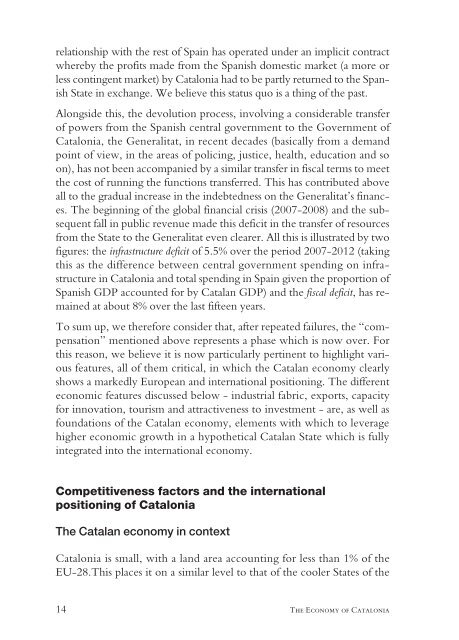The Economy of Catalonia
the_economy_of_catalonia._questions_and_answers_on_the_economic_impact_of_independence
the_economy_of_catalonia._questions_and_answers_on_the_economic_impact_of_independence
Create successful ePaper yourself
Turn your PDF publications into a flip-book with our unique Google optimized e-Paper software.
elationship with the rest <strong>of</strong> Spain has operated under an implicit contract<br />
whereby the pr<strong>of</strong>its made from the Spanish domestic market (a more or<br />
less contingent market) by <strong>Catalonia</strong> had to be partly returned to the Spanish<br />
State in exchange. We believe this status quo is a thing <strong>of</strong> the past.<br />
Alongside this, the devolution process, involving a considerable transfer<br />
<strong>of</strong> powers from the Spanish central government to the Government <strong>of</strong><br />
<strong>Catalonia</strong>, the Generalitat, in recent decades (basically from a demand<br />
point <strong>of</strong> view, in the areas <strong>of</strong> policing, justice, health, education and so<br />
on), has not been accompanied by a similar transfer in fiscal terms to meet<br />
the cost <strong>of</strong> running the functions transferred. This has contributed above<br />
all to the gradual increase in the indebtedness on the Generalitat’s finances.<br />
<strong>The</strong> beginning <strong>of</strong> the global financial crisis (2007-2008) and the subsequent<br />
fall in public revenue made this deficit in the transfer <strong>of</strong> resources<br />
from the State to the Generalitat even clearer. All this is illustrated by two<br />
figures: the infrastructure deficit <strong>of</strong> 5.5% over the period 2007-2012 (taking<br />
this as the difference between central government spending on infrastructure<br />
in <strong>Catalonia</strong> and total spending in Spain given the proportion <strong>of</strong><br />
Spanish GDP accounted for by Catalan GDP) and the fiscal deficit, has remained<br />
at about 8% over the last fifteen years.<br />
To sum up, we therefore consider that, after repeated failures, the “compensation”<br />
mentioned above represents a phase which is now over. For<br />
this reason, we believe it is now particularly pertinent to highlight various<br />
features, all <strong>of</strong> them critical, in which the Catalan economy clearly<br />
shows a markedly European and international positioning. <strong>The</strong> different<br />
economic features discussed below - industrial fabric, exports, capacity<br />
for innovation, tourism and attractiveness to investment - are, as well as<br />
foundations <strong>of</strong> the Catalan economy, elements with which to leverage<br />
higher economic growth in a hypothetical Catalan State which is fully<br />
integrated into the international economy.<br />
Competitiveness factors and the international<br />
positioning <strong>of</strong> <strong>Catalonia</strong><br />
<strong>The</strong> Catalan economy in context<br />
<strong>Catalonia</strong> is small, with a land area accounting for less than 1% <strong>of</strong> the<br />
EU-28.This places it on a similar level to that <strong>of</strong> the cooler States <strong>of</strong> the<br />
14 <strong>The</strong> <strong>Economy</strong> <strong>of</strong> <strong>Catalonia</strong>


